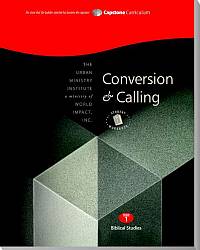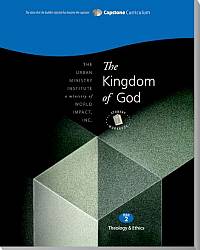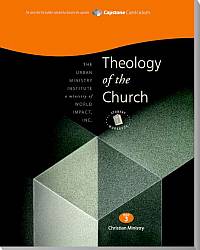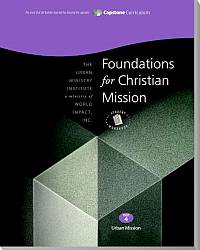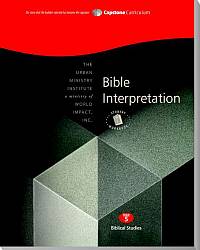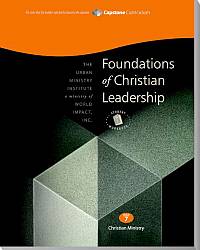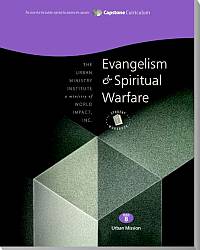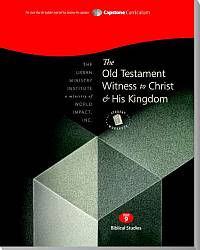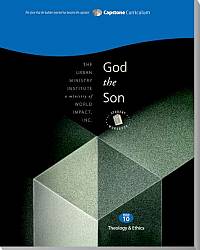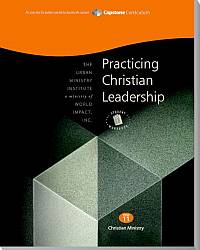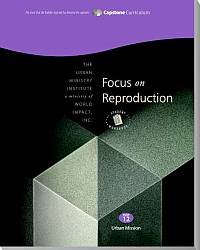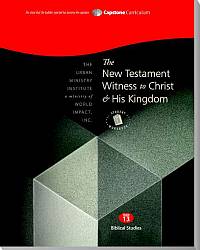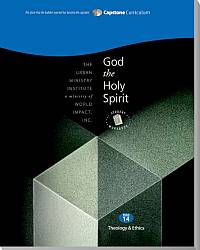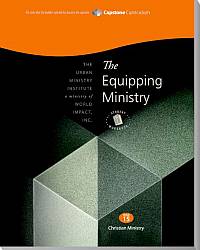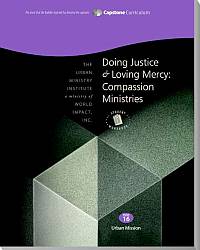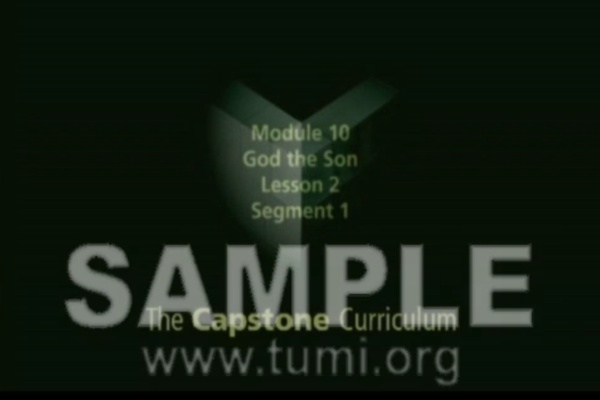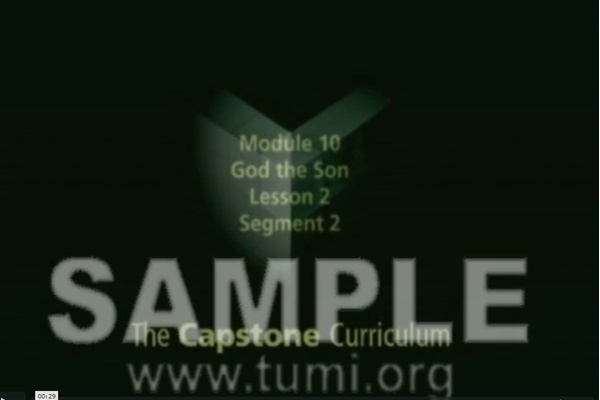The Capstone Curriculum 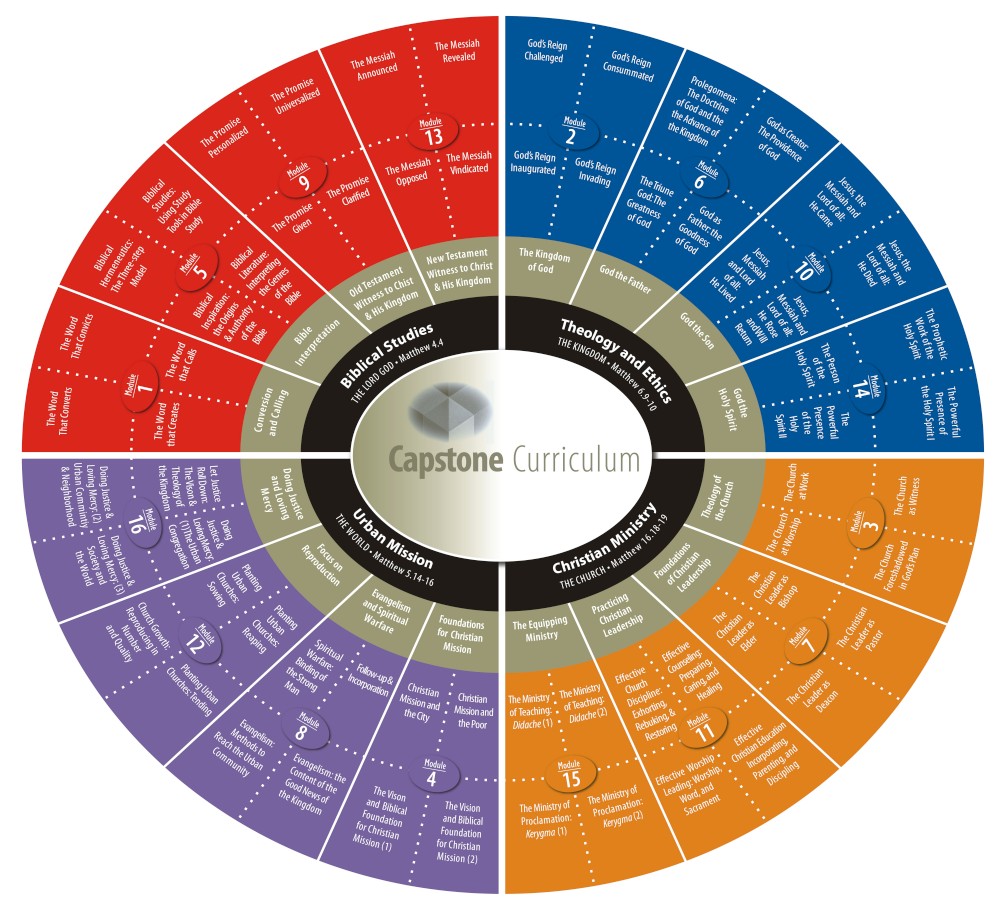
Capstone Curriculum is a 16-module training program, taught at a seminary level, which we specifically designed to serve as the most essential knowledge and skill learning necessary for effective urban ministry and church leadership.
Each module (course) comes with a Mentor’s Guide, a Student Workbook and two DVD’s (four hours of video). Each module also has required supplemental textbooks. This curriculum is designed to be used in a variety of formats, time frames, and venues. As a complete training curriculum, it may be accessed through The Urban Ministry Institute’s Satellite Certificate program. With this curriculum you will have everything you need to equip yourself and your leaders for effective ministry in your church and community.
Capstone Module Descriptions This document is a great tool to help you understand what each module is about in relatively few pages.

Overview
An Overview of the Capstone Curriculum
The Capstone Curriculum is a 16-module training program, taught at a seminary level, which we specifically designed to serve as the most essential knowledge and skill learning necessary for effective urban ministry and church leadership. Although each module contains its own specific list of objectives to guide mentors and students through the material, below you will find our eight overall objectives we seek to implement across our Capstone Curriculum:
- To ground emerging urban leaders in the Gospel of Christ, enabling them to know the basics of conversion and their own calling to salvation and leadership
- To root our students in the indispensability of the Church to serve as both agent and locus of the Kingdom, and for them to serve the church practically and specifically in the local assembly
- To equip urban leaders with the necessary study skills to study, apply, teach, preach, and minister the Word of God in the urban context, applying their learning in the context of their own personal lives and church ministries
- To challenge urban leaders to regularly memorize select portions of Scripture, and develop the discipline of review to retain and utilize texts both devotionally and in ministry
- To establish urban leaders in a Christ-centered vision of Scripture, and equip them in a Nicene-based, biblical theology that is congruent with the historic orthodox faith of the Great Tradition
- To provide a biblical foundation for both understanding and practicing Christian leadership in the context of the Church, with a special emphasis and appreciation for spiritual formation in urban communities, especially among the poor.
- To train urban leaders to evangelize, disciple, plant, pastor, and minister within evangelical urban churches which will be spiritually vital, culturally conducive, and aggressively reproductive within the various people groups needing Christ in the city
- To encourage urban leaders to find practical, meaningful ways to promote justice and demonstrate mercy with the broken and needy in urban communities, and discover ways to display hospitality, generosity, and compassion in the places where they live and minister
Each module (course) comes with a Mentor’s Guide, a Student Workbook and two DVD’s (four hours of video). Each module also has required supplemental textbooks. This curriculum is designed to be used in a variety of formats, time frames, and venues. As a complete training curriculum, it may be accessed through The Urban Ministry Institute’s Satellite Certificate program. With this curriculum you will have everything you need to equip yourself and your leaders for effective ministry in your church and community.
Accreditation and Capstone: An Overview of the Capstone Curriculum with all of the Module Descriptions and Lesson Objectives.
Here is a very helpful document that will give you information on Capstone for your review. This document will help you get a thorough understanding of the overall schema of Capstone as well as each particular module's content and objectives. This is the document that our partners have used to determine their level of accreditation for our resource and their institution of higher education. This is a great resource for your mentors!
The Capstone Curriculum at-a-glance
This two-page document provides an at-a-glance look at our entire Capstone Curriculum (including lesson titles), and also defines our terminology in this structure programming, along with breakdown of the modules and the outline of the lessons.
Capstone Circle Chart
Here is the one page view of all 16 Capstone Modules and their lessons.
Purchase the Capstone Curriculum
Sample Lesson
Capstone Module Lesson Sample
Are you interested in hearing actual module teaching? Feel free to preview one of the Capstone module’s instruction to gain a better understanding of what we’ve included in each module. Listening to the teaching may convince you that our training may be appropriate and desirable for your church or ministry leadership training!
 TUMI's Capstone Curriculum is a 16-module training program, taught at a seminary level, which we specifically designed to serve as the most essential knowledge and skill learning necessary for effective urban ministry. Capstone is modular in its design, which means the modules (courses) are complete in themselves, independent of each other and can be studied in any order.
TUMI's Capstone Curriculum is a 16-module training program, taught at a seminary level, which we specifically designed to serve as the most essential knowledge and skill learning necessary for effective urban ministry. Capstone is modular in its design, which means the modules (courses) are complete in themselves, independent of each other and can be studied in any order.
Each Capstone module has FOUR LESSONS, along with a set of assignments the students will need to complete for that module. Each lesson has one hour of video (broken into two parts we call video segments of 30 minutes each). In addition, mentors are given resources in the mentor guide to help them facilitate each Capstone Module, ensuring the students understand key elements of each lesson/module.
The workbook lesson outline (in its entirety) is available for you to download along with both video segments for you to view.
There are four lessons in each Capstone Module. Each lesson consists of the following:
- Devotion: Each lesson starts with a devotional integrated with the lesson’s theme and teaching material.
- Contacts: These exercises, many based on true happenings, are dialogue starters designed to “prime the pump,” so to speak, of both the students’s interests and imaginations about the topics covered in the upcoming lesson.
- Lesson Objectives: Each Capstone module lesson is structured around clear learning objectives which direct the student learning activities and serve as the thematic center of the teaching. They specifically state what each lesson hopes to attain, specifically what each student will grasp and learn as a result of that lesson’s interaction.
- Lesson Outline and Video: Each Lesson's teaching outline is broken into two parts, Segment 1 and Segment 2, and each segment has 30 minutes of video that coincide with the outline for that video segment in the workbook.
- Student Questions: Each video segment in each lesson concludes with clear review questions to encourage student interaction with the material, and to ensure they comprehend the meaning and significance of the concepts covered in the video segment.
- Summary of Key Concepts: At the end of a lesson, this section summarizes the main concepts covered in the presentation and materials covered, and is offered as a neat summary piece and resource for ready review later.
- Student Application/Implications: Also at the end of each lesson, we encourage students to reflect on the ramifications of the teaching for their life and ministry. Each lesson contains specific questions to encourage that kind of reflection and dialogue.
- Case Studies: The wisdom the students can glean from relating their knowledge to real, life case studies is invaluable. This section at the end of each lesson provides practical, realistic, and often true-to-life examples where the students can grapple with real life application of their teaching just covered in this lesson.
- Resources and Bibliographies: For further study, we provide 3-4 additional texts of interest in each lesson to encourage those interested to probe deeper into the complexities and implications of the concepts covered in the lesson.
- Ministry Connections: We encourage the students to seek to find connection and integration of the concepts and wisdom offered in the context of their own particular ministry responsibilities. This allows opportunities to apply the insights of the lesson right away, immediately in the outworking of their life and service.
A Capstone Module's Student Assignments
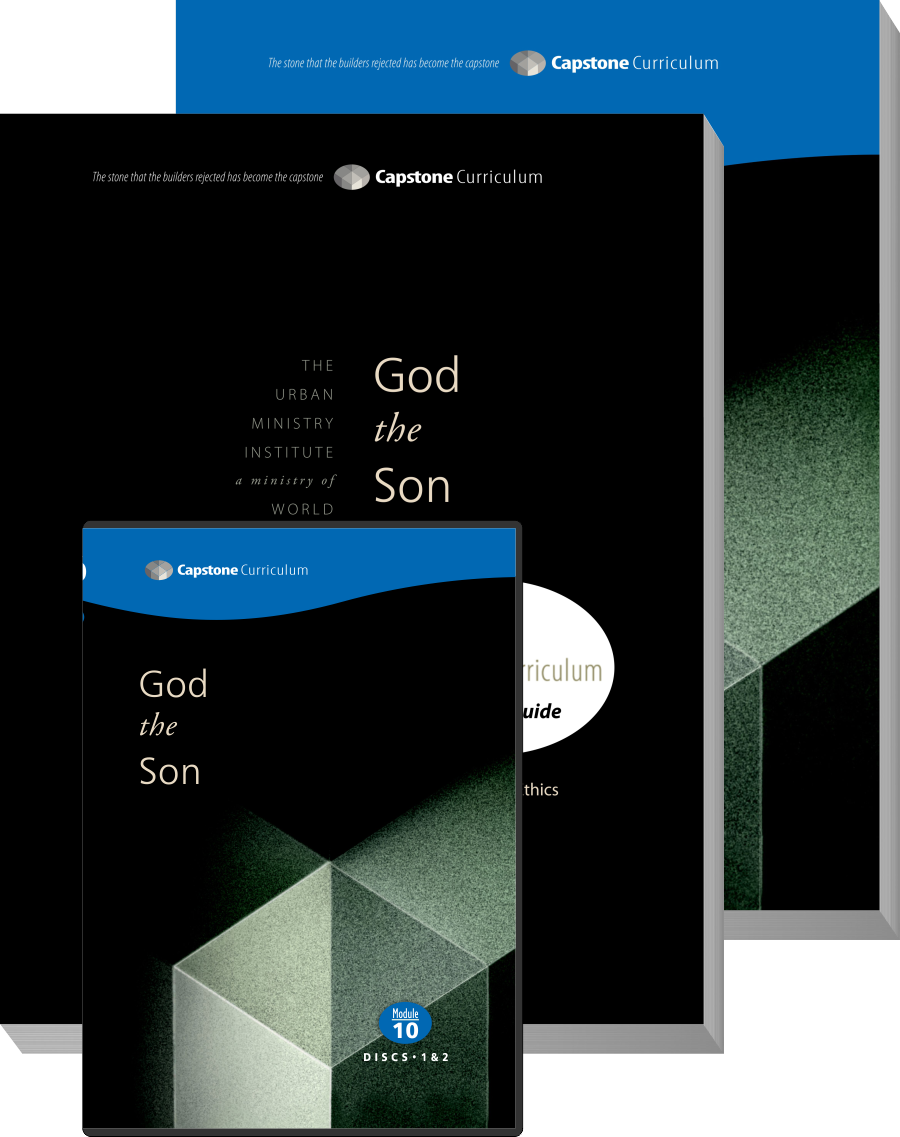 Each Capstone Module also has a set of assignments that the students will need to complete for that module:
Each Capstone Module also has a set of assignments that the students will need to complete for that module:
- Course Requirements: A summary of the assignments for this particular Capstone Module.
- Required Textbook Reading Assignments: We require students to purchase, read, and reflect upon the textbook(s) for each course. Students must read each required textbook and write a precis (concise summary) of its main point, as they see it.
- Scripture Memorization: For each module, there are three passages/references total that the students must memorize (one for lesson one, one for lesson two and one for lesson 3, none for lesson 4).
- Quizzes and Final Exam: The quizzes and final exam are designed to quiz students on the material covered in class. There are three quizzes (a quiz for lessons 1-3) and a final exam (questions from lesson 4 are incorporated into the final exam). The quizzes are taken in class and the final exam is typically a take home "closed book" exam.
- Exegetical Project: Each module contains an inductive Bible study assignment which requires the students to grapple with the Scripture’s teaching of the module’s subject matter.
- Ministry Project: At the end of each module’s study, we ask each student to design a practical ministry project where they can specifically share and apply their learning in the context of their personal lives and ministries.
Required Textbooks
Required Textbooks
Each Capstone module has assigned textbooks which are read and discussed through the course. We encourage students to read, reflect upon, and respond to these with their professors, mentors, and fellow learners. The current listing on our site will always represent the OFFICIAL Capstone required textbook list.
Module 1
-
Lesson 1: Reading Assignments
By the conclusion of this lesson, you should have read the following:
- Erickson, Introducing Christian Doctrine, 2nd Edition Chapters 4-5.; 3rd Edition Chapters 3-4
Geisler, To Understand the Bible Look for Jesus, Chapters 1-2.
Packer, God Has Spoken: Revelation and the Bible, Chapters 1-2.
-
Lesson 2: Reading Assignments
By the conclusion of this lesson, you should have read the following:
- Erickson, Introducing Christian Doctrine, 2nd Edition Chapters 6-7; 3rd Edition Chapters 5-6.
Geisler, To Understand the Bible Look for Jesus, Chapters 3-4.
Packer, God Has Spoken: Revelation and the Bible, Chapters 3-4
-
Lesson 3: Reading Assignments
By the conclusion of this lesson, you should have read the following:
- Erickson, Introducing Christian Doctrine, 2nd Edition Chapters 33-34; 3rd Edition Chapters 33-34.
Geisler, To Understand the Bible Look for Jesus, Chapters 5-6.
Packer, God Has Spoken: Revelation and the Bible, 5-6.
- 1
Module 2
-
Lesson 1: Reading Assignments
By the conclusion of this lesson, you should have read the following:
Ladd, Gospel of the Kingdom: Scriptural Studies in the Kingdom of God, Introduction, Chapters 1-111.
Snyder, Kingdom, Church and World: Biblical Themes for Today, Chapters 1-4.
-
Lesson 2: Reading Assignments
By the conclusion of this lesson, you should have read the following:
Ladd, Gospel of the Kingdom: Scriptural Studies in the Kingdom of God, Chapters IV-VI.
Snyder, Kingdom, Church and World: Biblical Themes for Today, Chapters 5-8.
Cornett and Davis, Thy Kingdom Come! Readings on the Kingdom of God (Appendix 21), pp. 114-125; 134-170.
-
Lesson 3: Reading Assignments
By the conclusion of this lesson, you should have read the following:
Ladd, Gospel of the Kingdom: Scriptural Studies in the Kingdom of God, Chapters VII-IX.
Snyder, Kingdom, Church and World: Biblical Themes for Today, Chapters 9-11.
- 1
Module 3
-
Lesson 1: Reading Assignments
By the conclusion of this lesson, you should have read the following:
Erickson, Introducing Christian Doctrine, 2nd Edition - Chapters 33-34; 3rd Edition - Chapters 33-34.
Snyder, The Community of the King, Intro, Part 1.
Davis, Sacred Roots, Intro, Chapters 1-4.
Allsman, Jesus Cropped from the Picture, Part 1. -
Lesson 2: Reading Assignments
By the conclusion of this lesson, you should have read the following:
Erickson, Introducing Christian Doctrine, 2nd Edition - Chapter 36; 3rd Edition - Chapter 36.
Snyder, The Community of the King, Part 2.
Davis, Sacred Roots, Chapters 5-9.
Allsman, Jesus Cropped from the Picture, Part 2. -
Lesson 3: Reading Assignments
By the conclusion of this lesson, you should have read the following:
Erickson, Introducing Christian Doctrine, 2nd Edition - Chapter 37 "The Functions of the Church"; 3rd Edition - Chapter 37 "The Functions of the Church".
Snyder, The Community of the King, Part 3.
Davis, Sacred Roots, Chapter 10, Epilogue.
Allsman, Jesus Cropped from the Picture, Part 3.
- 1
Module 4
-
Lesson 1: Reading Assignments
By the conclusion of this lesson, you should have read the following:
Bakke, A Theology as Big as the City, Introduction, Chapters 1-8.
Webber, Who Gets to Narrate the World?: Contending for the Christian Story in an Age of Rivals, Introduction, Chapters 1-2.
Piper, Let the Nations be Glad, Introduction, Part I.
Snyder, Kingdom, Church and World: Biblical Themes for Today, Chapters 1-4. -
Lesson 2: Reading Assignments
By the conclusion of this lesson, you should have read the following:
Bakke, A Theology as Big as the City, Chapters 9-18.
Webber, Who Gets to Narrate the World?: Contending for the Christian Story in an Age of Rivals, Chapters 3-5.
Piper, Let the Nations be Glad, Part 2.
Snyder, Kingdom, Church and World: Biblical Themes for Today, Chapters 5-8. -
Lesson 3: Reading Assignments
By the conclusion of this lesson, you should have read the following:
Bakke, A Theology as Big as the City, Chapters 19-26.
Webber, Who Gets to Narrate the World?: Contending for the Christian Story in an Age of Rivals, Chapters 3-5.
Piper, Let the Nations be Glad, Part 3, Conclusions, Afterward.
Snyder, Kingdom, Church and World: Biblical Themes for Today, Chapters 9-11.
- 1
Module 5
-
Lesson 1: Reading Assignments
By the conclusion of this lesson, you should have read the following:
Erickson, Introducing Christian Doctrine, 2nd Edition - Chapters 1-3; 3rd Edition - Chapters 1-2.
Geisler, To Understand the Bible Look for Jesus, Chapters 1-2.
Fee, How to Read the Bible for All its Worth, Chapters 1-4.
Wald, The New Joy of Discovery in Bible Study, Introduction, Part I. -
Lesson 2: Reading Assignments
By the conclusion of this lesson, you should have read the following:
Erickson, Introducing Christian Doctrine, 2nd Edition - Chapters 4-5; 3rd Edition - Chapters 4-5.
Geisler, To Understand the Bible Look for Jesus, Chapters 3-4.
Fee, How to Read the Bible for All its Worth, pp. 94-186.
Wald, The New Joy of Discovery in Bible Study, Part II (Chapters 7-10). -
Lesson 3: Reading Assignments
By the conclusion of this lesson, you should have read the following:
Erickson, Introducing Christian Doctrine, 2nd Edition - Chapters 6-8; 3rd Edition - Chapters 5-7.
Geisler, To Understand the Bible Look for Jesus, Chapters 5-6.
Fee, How to Read the Bible for All its Worth, pp. 187-245.
Wald, The New Joy of Discovery in Bible Study, Part II (Chapters 11-14).
- 1
Module 6
-
Lesson 1: Reading Assignments
By the conclusion of this lesson, you should have read the following:
Erickson, Introducing Christian Doctrine, 2nd Edition - Chapters 14-15; 3rd Edition - Chapters 13-14.
Packer, Knowing God, Part I.
Tozer, The Knowledge of the Holy: The Attributes of God: Their Meaning in the Christian Life, Chapters 1-7.
Dodd, Dictionary of Theological Terms in Simplified English: A Resource for English-Language Learners (please refer to the dictionary throughout this course as needed), -
Lesson 2: Reading Assignments
By the conclusion of this lesson, you should have read the following:
Erickson, Introducing Christian Doctrine, 2nd Edition - Chapters 10 & 12; 3rd Edition - Chapters 9 &11.
Packer, Knowing God, Part II.
Tozer, The Knowledge of the Holy: The Attributes of God: Their Meaning in the Christian Life, Chapters 8-15.
Dodd, Dictionary of Theological Terms in Simplified English: A Resource for English-Language Learners (please refer to the dictionary throughout this course as needed), -
Lesson 3: Reading Assignments
By the conclusion of this lesson, you should have read the following:
Erickson, Introducing Christian Doctrine, 2nd Edition - Chapters 11 & 16; 3rd Edition - Chapters 10 & 15.
Packer, Knowing God, Part III.
Tozer, The Knowledge of the Holy: The Attributes of God: Their Meaning in the Christian Life, Chapters 16-23.
Dodd, Dictionary of Theological Terms in Simplified English: A Resource for English-Language Learners (please refer to the dictionary throughout this course as needed),
- 1
Module 7
-
Lesson 1: Reading Assignments
By the conclusion of this lesson, you should have read the following:
Allsman, The Heroic Venture, Introduction, Section One.
Bennett, Metaphors of Ministry: Biblical Images for Leaders and Followers, Introduction, Part I.
Getz, Elders and Leaders, Introduction, Chapters 1-14.
-
Lesson 2: Reading Assignments
By the conclusion of this lesson, you should have read the following:
Allsman, The Heroic Venture, Section Two.
Bennett, Metaphors of Ministry: Biblical Images for Leaders and Followers, Part 2 (Chapters 6-10).
Getz, Elders and Leaders, Chapters 15-27.
-
Lesson 3: Reading Assignments
By the conclusion of this lesson, you should have read the following:
Allsman, The Heroic Venture, Section Three.
Bennett, Metaphors of Ministry: Biblical Images for Leaders and Followers, Part 2 (Chapters 7-11; Part 3.
Getz, Elders and Leaders, Chapters 28-37.
- 1
Module 8
-
Lesson 1: Reading Assignments
By the conclusion of this lesson, you should have read the following:
Erickson, Introducing Christian Doctrine, 2nd Edition - Chapters 17; 3rd Edition - Chapters 16 PRISON EDITION, for Prison Students ONLY: SOFTCOVER, Introducing Christian Doctrine,
Fish, Every Member Evangelism for Today, Part I (Chapters 1-3).
Anderson, Victory Over the Darkness: Realizing the Power of Your Identity in Christ, Introduction, Chapters 1-4.
-
Lesson 2: Reading Assignments
By the conclusion of this lesson, you should have read the following:
Fish, Every Member Evangelism for Today, Part II (Chapters 4-5).
Anderson, Victory Over the Darkness: Realizing the Power of Your Identity in Christ, Chapters 5-8.
-
Lesson 3: Reading Assignments
By the conclusion of this lesson, you should have read the following:
Fish, Every Member Evangelism for Today, Part III (Chapters 6-7).
Anderson, Victory Over the Darkness: Realizing the Power of Your Identity in Christ, Chapters 9-13.
- 1
Module 9
-
Lesson 1: Reading Assignments
By the conclusion of this lesson, you should have read the following:
Wright, Knowing Jesus Through the Old Testament, Chapters 1-2
Geisler, To Understand the Bible Look for Jesus, Chapters 1-2.
Geisler, A Popular Survey of the Old Testament, Part 1-2.
-
Lesson 2: Reading Assignments
By the conclusion of this lesson, you should have read the following:
Wright, Knowing Jesus Through the Old Testament, Chapters 3-4
Geisler, To Understand the Bible Look for Jesus, Chapters 3-4.
Geisler, A Popular Survey of the Old Testament, Part 3-4.
-
Lesson 3: Reading Assignments
By the conclusion of this lesson, you should have read the following:
Wright, Knowing Jesus Through the Old Testament, Chapters 5
Geisler, To Understand the Bible Look for Jesus, Chapters 5-6.
Geisler, A Popular Survey of the Old Testament, Part 5.
- 1
Module 10
-
Lesson 1: Reading Assignments
By the conclusion of this lesson, you should have read the following:
Erickson, Introducing Christian Doctrine, 2nd Edition Chapter 24; 3rd Edition, Chapter 23 .
Bowman, Putting Jesus in His Place: The Case for the Deity of Christ, Intro, Part 1.
Demarest, Who is Jesus? Further Reflections on Jesus Christ: The God-Man, Chapters 1-4 -
Lesson 2: Reading Assignments
By the conclusion of this lesson, you should have read the following:
Erickson, Introducing Christian Doctrine, 2nd Edition Chapter 26; 3rd Edition= Chapter 25 .
Bowman, Putting Jesus in His Place: The Case for the Deity of Christ, Part 2-3.
Demarest, Who is Jesus? Further Reflections on Jesus Christ: The God-Man, Chapters 5-8 -
Lesson 3: Reading Assignments
By the conclusion of this lesson, you should have read the following:
Erickson, Introducing Christian Doctrine, 2nd Edition Chapters 27-28; 3rd Edition- Chapters 26-27.
Bowman, Putting Jesus in His Place: The Case for the Deity of Christ, Part 4-5, Conculsion.
Demarest, Who is Jesus? Further Reflections on Jesus Christ: The God-Man, Chapters 9-12.
- 1
Module 11
-
Lesson 1: Reading Assignments
By the conclusion of this lesson, you should have read the following:
World Wide Publications, The Billy Graham Christian Worker's Handbook, Intro, Steps to Peace with God - Drug Abuse
Carter, The Gifted Pastor, Intro, Chapters 1-3.
Cothen and Barlow, Equipped for Good Work: A Guide for Pastors, Chapters 1-5.
-
Lesson 2: Reading Assignments
By the conclusion of this lesson, you should have read the following:
World Wide Publications, The Billy Graham Christian Worker's Handbook, Employment, Loss of -Marriage (Winning One's Mate to Christ)
Carter, The Gifted Pastor, Chapters 4-6.
Cothen and Barlow, Equipped for Good Work: A Guide for Pastors, Chapters 6-10.
-
Lesson 3: Reading Assignments
By the conclusion of this lesson, you should have read the following:
World Wide Publications, The Billy Graham Christian Worker's Handbook, Mental Illness - A Comparison of Christianity with Major Religions and Cults
Carter, The Gifted Pastor, 7-11.
Cothen and Barlow, Equipped for Good Work: A Guide for Pastors, Chapters 11-16.
- 1
Module 12
-
Lesson 1: Reading Assignments
By the conclusion of this lesson, you should have read the following:
Shenk and Stutzman, Creating Communities of the Kingdom: New Testament Models of Church Planting, Chapters 1-4
Mull, A Biblical Church Planting Manual: From the Book of Acts, Introduction - Three (Provides a Place of Prayer to meet God with Others).
Phillips, Out of Ashes, Section I-II.
-
Lesson 2: Reading Assignments
By the conclusion of this lesson, you should have read the following:
Shenk and Stutzman, Creating Communities of the Kingdom: New Testament Models of Church Planting, Chapters 5-8
Mull, A Biblical Church Planting Manual: From the Book of Acts, Four (Provides a Public Preaching Place)- Eight (Trains Lay Leaders to Become Preachers).
Phillips, Out of Ashes, Section III.
Also read the following articles which are located in the Appendix of your student workbook:
Decker, Frank. When "Christian" Does Not Translate
Kraft, Charles. Pursuing Faith, Not Religion: The Liberating Quest for Contextualization
Lewis, Rebecca. Missions in the 21st Century: Working with Social Entrepreneurs?
McGavran, Donald. A People Reborn: Foundational Insights on People Movements
Travis, John and Anna. Contextualization Among Hindus, Muslims, and Buddhists: A Focus on "Insider Movements."
Winter, Ralph D. Editorial
All articles are taken from Mission Frontiers: The Bulletin of the US Center for World Mission, Vol. 27, No. 5; September-October 2005; ISSN 0889-9436. Copyright 2005 by the U.S. Center for World Missions. Used by Permission. All Rights Reserved
-
Lesson 3: Reading Assignments
By the conclusion of this lesson, you should have read the following:
Shenk and Stutzman, Creating Communities of the Kingdom: New Testament Models of Church Planting, Chapters 9-13
Mull, A Biblical Church Planting Manual: From the Book of Acts, Nine (Cross Cultural Barriers) - Twelve (Starts Other Churches).
Phillips, Out of Ashes, Section IV-V.
- 1
Module 13
-
Lesson 1: Reading Assignments
By the conclusion of this lesson, you should have read the following:
Geisler, To Understand the Bible Look for Jesus, Chapters 1-2
Stott, The Incomparable Christ, Introduction, Part I.
Elwell and Yarbrough, Encountering the New Testament: A Historical and Theological Survey (Encountering Biblical Studies), Chapters 1-8.
-
Lesson 2: Reading Assignments
By the conclusion of this lesson, you should have read the following:
Geisler, To Understand the Bible Look for Jesus, Chapters 3-4
Stott, The Incomparable Christ, Part II-Part III (Ch. 1-6).
Elwell and Yarbrough, Encountering the New Testament: A Historical and Theological Survey (Encountering Biblical Studies), Chapters 9-16.
-
Lesson 3: Reading Assignments
By the conclusion of this lesson, you should have read the following:
Geisler, To Understand the Bible Look for Jesus, Chapters 5-6
Stott, The Incomparable Christ, Part III (Ch. 7-12, Conculsion), Part IV, Conclusion.
Elwell and Yarbrough, Encountering the New Testament: A Historical and Theological Survey (Encountering Biblical Studies), Chapters 11-16.
- 1
Module 14
-
Lesson 1: Reading Assignments
By the conclusion of this lesson, you should have read the following:
Erickson, Introducing Christian Doctrine, 2nd Edition - Chapter 29; 3rd Edition, Chapter 28.
Keener, Gift and Giver: The Holy Spirit for Today, Intro, Chapters 1-3 (and the Appendix, "What Can Bible Stories Teach Us?").
Pritchard, Names of the Holy Spirit , ("Spirit above the Water," p. 11; "Mind of the Lord, p. 55; "His Spirit," p. 59; "Power of the Lord," p. 88; "God" p. 118). -
Lesson 2: Reading Assignments
By the conclusion of this lesson, you should have read the following:
Erickson, Introducing Christian Doctrine, "The Work of the Holy Spirit in the Old Testament" 2nd Edition- Chapter 30; 3rd Edition- Chapter 29.
Keener, Gift and Giver: The Holy Spirit for Today, Chapters 4-7.
Pritchard, Names of the Holy Spirit , ("Breath of Life," p. 13; "The Anointing," p. 199; "Spirit of Prophecy," p. 209; "Spirit of Justice," p. 49; "Spirit of Christ," p. 129). -
Lesson 3: Reading Assignments
By the conclusion of this lesson, you should have read the following:
Erickson, Introducing Christian Doctrine, "The Work of the Holy Spirit in the Life of a Christian," 2nd Edition - Chapter 30; 3rd Edition - Chapter 29; "Sanctification," 2nd Edition - Chapter 35; 3rd Edition - Chapter 35; "The Miraculous Gifts Today," 2nd Edition - Chapter 30, 3rd Edition - Chapter 29.
Keener, Gift and Giver: The Holy Spirit for Today, Chapters 8-10, Conclusion.
Pritchard, Names of the Holy Spirit , ("Water," p. 77; "Fire", p. 110, "Seal,", p. 165; "Oil," p. 19.
- 1
Module 15
-
Lesson 1: Reading Assignments
By the conclusion of this lesson, you should have read the following:
Davis, Handbook of Basic Bible Texts, Chapters 1-4.
Long, The Witness of Preaching, 2nd edition, Introduction, Chapters 1-2.
Davis, A Sojourner's Quest , Introduction, Part I. Stevens, The Equipper's Guide to Every-Member Ministry, Introduction, Chapters 1-2. -
Lesson 2: Reading Assignments
By the conclusion of this lesson, you should have read the following:
Davis, Handbook of Basic Bible Texts, Chapters 5-8.
Long, The Witness of Preaching, 2nd edition, Chapters 3-6.
Davis, A Sojourner's Quest , Part II. Stevens, The Equipper's Guide to Every-Member Ministry, Chapters 3-5. -
Lesson 3: Reading Assignments
By the conclusion of this lesson, you should have read the following:
Davis, Handbook of Basic Bible Texts, Chapters 9-12.
Long, The Witness of Preaching, 2nd edition, Chapters 7-10.
Davis, A Sojourner's Quest , Part III-IV. Stevens, The Equipper's Guide to Every-Member Ministry, Chapters 6-8, Epilogue.
- 1
Module 16
-
Lesson 1: Reading Assignments
By the conclusion of this lesson, you should have read the following:
Keller, Ministries of Mercy: The Call of the Jericho Road, Introduction, Chapters 1-5
Stott, Issues Facing Christians Today, Chapters 1-5.
-
Lesson 2: Reading Assignments
By the conclusion of this lesson, you should have read the following:
Keller, Ministries of Mercy: The Call of the Jericho Road, Chapters 6-10
Stott, Issues Facing Christians Today, Chapters 6-10.
-
Lesson 3: Reading Assignments
By the conclusion of this lesson, you should have read the following:
Keller, Ministries of Mercy: The Call of the Jericho Road, Chapters 11-14
Stott, Issues Facing Christians Today, Chapters 11-17.
- 1
Appendices
Appendices
TUMI’s Core Texts Bibliography
As theologians and research scholars, TUMI's faculty had a wide range of excellent text from which to choose in selecting those texts which would become the staple of its training program for urban church leadership development. Do you want to know what we settled on to be must-have-and-own list of books for an emerging urban Christian leader? Here it is in printable form!
TUMI's core texts represent an representative core of evangelically orthodox texbooks which emphasize a Nicene creedal theology. They confess the essential beliefs represented broadly in an evangelical consensus by various denominations and traditions, and provide a well-rounded introduction to the major issues of faith and practice for Christian leadership. Texts were chosen not only on the basis of scholarly acumen and breadth, but also on our more fundamental criteria for urban leadereship training, i.e., accessibility and usuability, readability level, clarity and practicality, along with historic orthodox content consistent with Nicene theology. To keep the student textbook collection affordable, we use these books again and again in our various department areas, referred to them throughout the course of our instruction. We regularly employ these texts in all the various classes and workshops we sponsor.
Recommended Books to Start Your Own Theological Library
We strongly recomend that every satellite do all it can to establish a theological libary collection in connection to its leadership education, both for the sake of faculty studies and student preparation. Such a limited but helpful collection can enhance your training opportunities greatly, and enable you to better serve your students at your satellite, Here is a starter list to help you begin to consider the kinds of texts you should obtain for your satellite and/or personal library collection.
